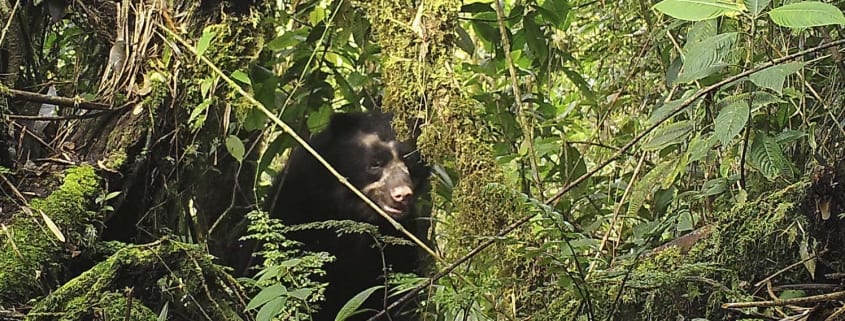Camera Traps Provide Insight into Spectacled Bear Populations in Ecuador
Conservationists and researchers working with Rainforest Trust’s partner Fundación Jocotoco installed 20 camera traps in the Antisanilla, Yanancocha and Tapichalaca Reserves in Ecuador as part of a Spectacled Bear study to document the species’ population. Sponsored by Rainforest Trust, this study aims to create a targeted monitoring system that will enable the partner to estimate the amount of bears residing within and passing through these reserves.
This data is crucial to collect, as it is expected that the global species’ population is decreasing due to habitat fragmentation as well as poaching. Rainforest Trust is supporting this study because gathering bear population estimates will enable its partner to better understand how to manage activities within and around the reserves that affect the species. The camera installations could also help monitor changes in the altitudinal distributions of the bears, as well as potentially uncover illegal hunting.
Eight Spectacled Bears have been identified through camera trap evidence in the Tapichalaca Reserve since 2015, and four have been registered in the Yanacocha Reserve. Seven individual bears – including a female and its cub – have been documented in the Antisanilla Reserve, although this data was not gathered during this specific study.
The partner is currently sorting the bear images so they can better identify the individuals by their face markings. In addition to confirming the species’ presence in the reserves, the results of this ongoing study have provided unexpected insights. In some camera trap images, instead of the distinctive black and white facial markings of a Spectacled Bear, researchers saw the piercing caramel eyes of a Puma staring intensely at something just below the camera lens.
Pumas are some of the most widely distributed mammals, as they have a geographic range from Canada down to Chile. Although they are found in numerous countries, these large cats are threatened by the fragmentation of their habitat. They are also challenged by the poaching of their prey, as well as retaliatory hunting if they disturb livestock populations.




